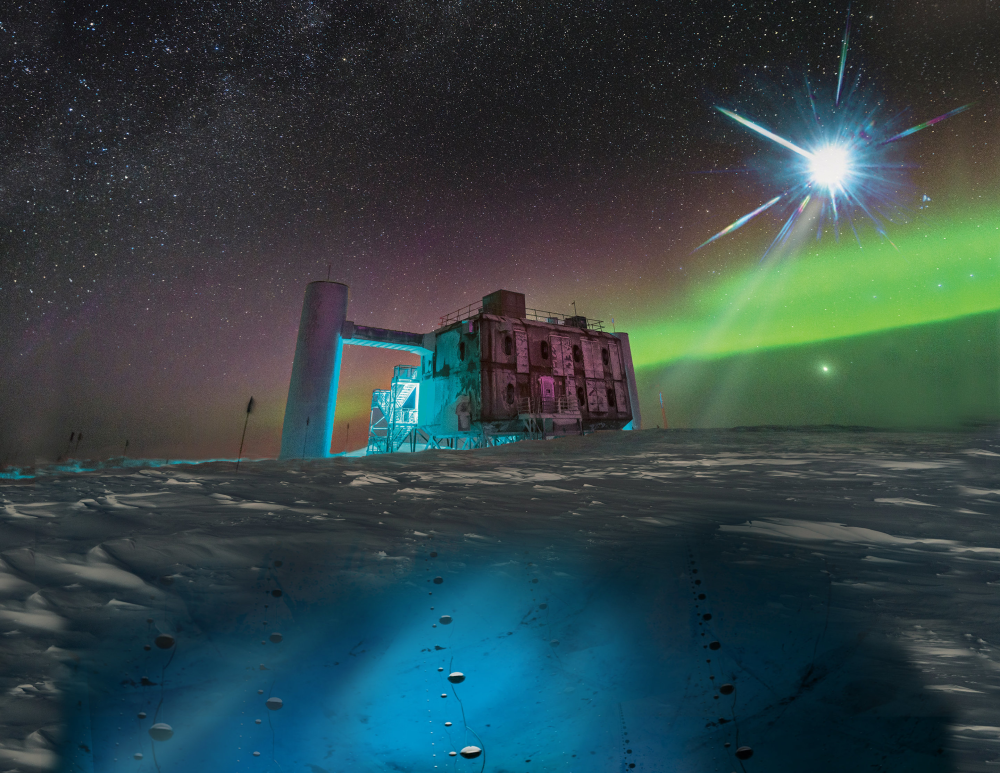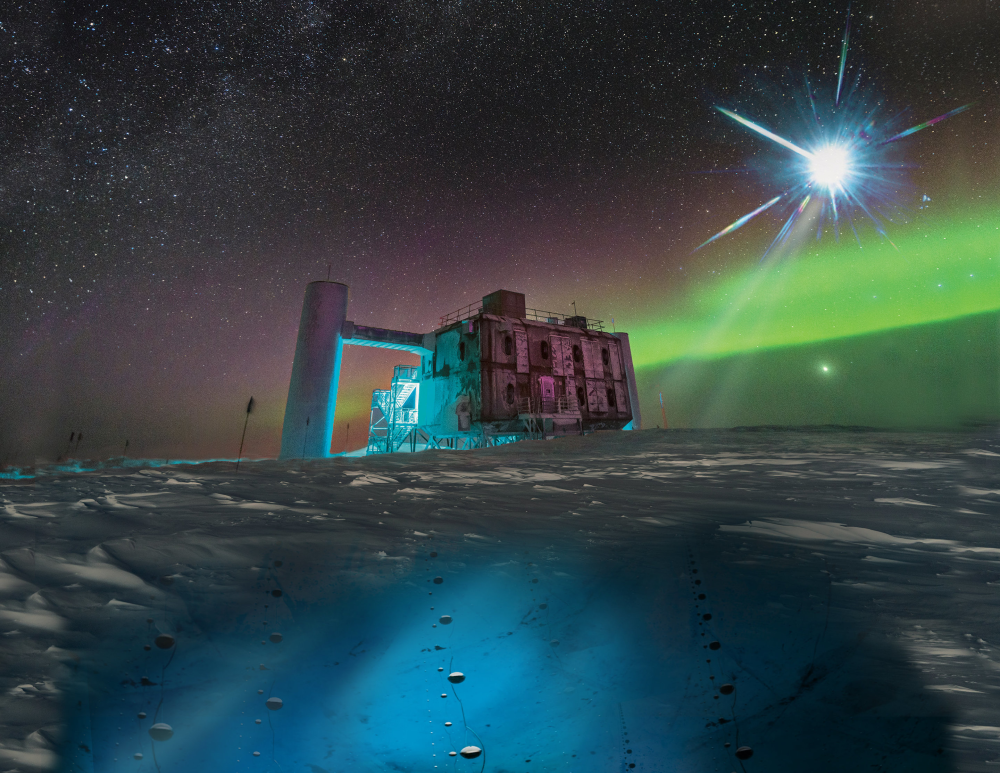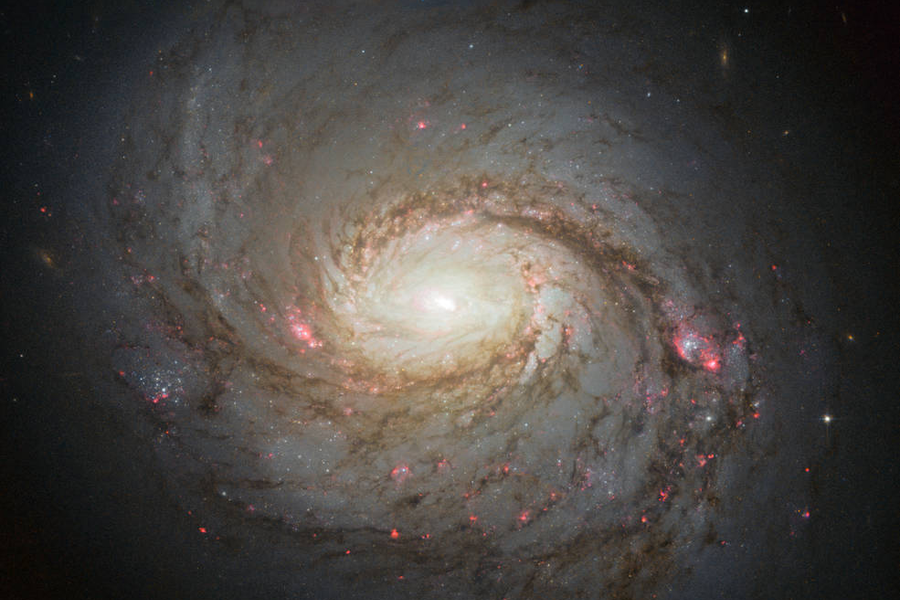Neutrino Astronomy Enters a New Era
Don your binoculars for a night of star gazing and you might be able to spot the seemingly innocuous spiral galaxy Messier 77 (M77), a bright but dusty mass of stars that sits 47 million light-years from Earth. Hidden under this dust is a supermassive black hole that is powering intense radiation from the surrounding gas. Now the IceCube Collaboration reports that they have found evidence that this galaxy is also a source of high-energy cosmic neutrinos [1]. Collaboration members say that the finding paves the way to using cosmic neutrinos for astrophysical measurements that could help solve the origin of cosmic rays, the Universe’s highest-energy particles, and help solve mysteries about cosmic rays and dark matter.
“This observation marks the dawn of being able to really do neutrino astronomy,” says IceCube member and Massachusetts Institute of Technology professor Janet Conrad. “We’ve struggled for so long to see potential cosmic neutrino sources at very high significance and now we’ve seen one,” she says. “We’ve broken a barrier.”
Cosmic neutrinos count among the Universe’s most energetic and most abundant particles. They also rank among its least interactive. Produced by so-called cosmic accelerators, cosmic neutrinos can zip unimpeded through light years of normal matter. This low interaction probability is problematic when it comes to detecting neutrinos—they can easily pass unnoticed through a detector. But the lack of interactions is a bonus for determining the path that a detected cosmic neutrino took from its source to Earth.
Researchers hope that by backtracking the paths of many cosmic neutrinos, they will be able to pinpoint the accelerators that produced them. These accelerators are expected to be the source of not only high-energy neutrinos but also high-energy cosmic rays. The latter have astonishing energies—over a million times greater than the energies of particles inside laboratory-based particle colliders. Where (and how) nature creates such high-energy cosmic rays has remained a long-standing mystery. Neutrinos could help pinpoint cosmic accelerators and also offer a probe of their inner workings. “The dream—or at least my dream—is to be able to run particle-physics experiments in astrophysical settings,” says IceCube member and Technical University of Munich professor Elisa Resconi, whose team led the data analysis for this new study.
The IceCube Neutrino Observatory lies in Antarctica, not far from the South Pole. The observatory’s optical sensors sit between 1.5 and 2 km below Antarctica’s surface in a 3D array that encompasses 1 km3 of optically transparent glacial ice. When a neutrino interacts with the nucleus of an atom in this ice, charged particles are produced. These particles then emit ultraviolet and blue photons that the sensors pickup.
In 2018, the IceCube Collaboration reported the detection of a flare of neutrinos that seemed to be coming from a blazar, a gamma-ray emitting jet powered by a supermassive black hole. That coincidence between a blazar and a flare of neutrinos has left open many questions, as the electromagnetic signals coming from the blazar don’t match those expected from neutrino models. Researchers have therefore been interested in locating other cosmic neutrino sources.
M77 has been on IceCube’s radar for several years. The collaboration first found hints of neutrinos coming from M77 back in 2020, when they reported they had found an excess—a peak above the Universe’s background neutrino level—of 63 neutrinos coming from the galaxy’s location (see Synopsis: Possible Neutrino Sources Peek out of IceCube Data). But that result was of low enough statistical significance (2.9 sigma) that the signal could have been a random fluctuation in the background level.
After completing the 2020 analysis, collaboration members set to work on updating their data analysis techniques, incorporating machine-learning methods to better reconstruct the trajectories and energies of detected photons. “At lower energies, on average, the previous reconstruction method was returning an energy value that was too high and that had a large uncertainty,” says IceCube spokesperson Ignacio Taboada from the Georgia Institute of Technology. Collaboration members also recalibrated IceCube’s optical sensors. They then reprocessed—in one shot—a decade’s worth of data to find signals of high-energy neutrinos.
This reprocessing flagged around 670,000 neutrino events, most of which, because of their energies, were likely produced in Earth’s atmosphere. Just a few thousand events were assigned to cosmic neutrinos. Of those, 79 were linked to M77, with a statistical significance of 4.2 sigma. This significance value is high enough that Resconi, Taboada, and others are confident that this signal won’t go away with further observations. “[The finding] is not yet above the famous ‘5 sigma,’ level,” Resconi says. “But if we could rerun the same experiment many, many times, the likelihood that we would get this result by chance is less that 1 in 100,000.”
M77’s central black hole is largely hidden from view by a blanket of gas and dust that absorbs light in most frequency bands. Nevertheless, models suggest that this black hole could be a cosmic accelerator, producing cosmic rays and the observed neutrinos, says IceCube member and University of Wisconsin-Madison professor Francis Halzen. He cautions however that it is “too early to claim that the [IceCube Collaboration] has solved the cosmic-ray-source problem.”
John Beacom, a neutrino physicist from Ohio State University, who is not part of the IceCube Collaboration, offers even more caution about naming M77 a cosmic accelerator. “I’m worried that this association with M77 would be too lucky,” he says. The “luck” is that M77-like galaxies are common, so there should be many neutrino sources in the Universe. Beacom argues that so many sources would conflict with measurements of the diffuse neutrino background. While he doesn’t question that IceCube has seen 79 cosmic neutrinos emanating from the direction of M77, the detector can’t determine the distance that the neutrinos have traveled. He notes that it’s possible that the real source is located behind M77.
Beacom says that, even with improvements, the current IceCube detector likely won’t be able to settle the question of cosmic neutrino sources. But it could be solved by IceCube-Gen2—a planned 10-km3 neutrino detector that researchers expect to place in Antarctica’s ice in the next three to four years. “It is going to take a bigger detector to really decide what source or sources IceCube has seen,” Beacom says. “But this result is an encouraging hint that having the bigger detector will be a profitable direction for this field.”
Taboada is also cautiously optimistic that a larger detector will significantly improve the understanding of the origin of the M77 neutrinos. But even without that knowledge, he says that the new finding is a significant milestone. Resconi agrees. She notes that when she started working on IceCube, there was no guarantee of spotting a neutrino source. “Without any safety net or security, we have landed on something quite exciting,” she says.
–Katherine Wright
Katherine Wright is the Deputy Editor of Physics Magazine.
References
- The IceCube Collaboration, “Evidence for neutrino emission from the nearby active galaxy NGC 1068,” Science 378, 538 (2022).






